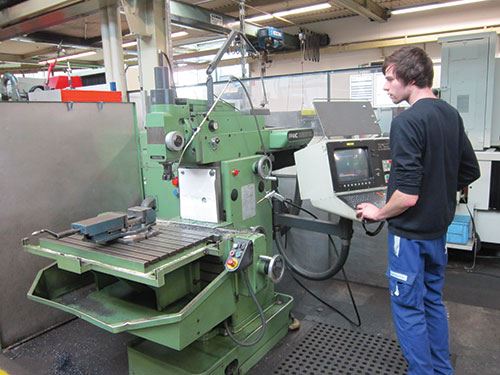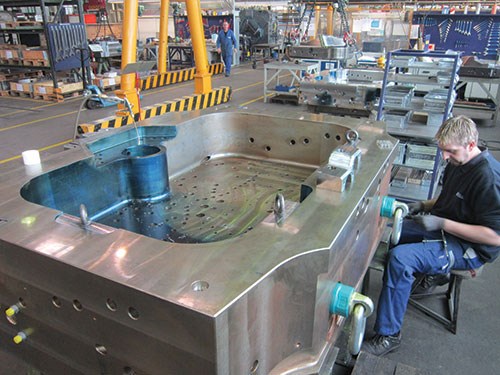Knowledge as a Core Competency
This German manufacturer’s competitiveness depends on not only a streamlined workflow, but also a deep understanding of customer needs and a reliable influx of skilled employees.
Keeping up with technology isn’t a panacea for success.
That was my first thought upon concluding a whirlwind tour of Heck and Becker, a German manufacturer of die-cast dies that I had the opportunity to visit during an excursion away from the Euromold show this past December. Given Germany’s general reputation for quality and reliability, I was impressed but not surprised to find a clean, orderly shop floor populated with some of the latest, most sophisticated manufacturing equipment. However, Ralf Fett, production manager, was just as eager to tout the knowledge and expertise that underlie everything the company does, from specific shopfloor operations to high-level strategic decisions.
It all starts with the German education system, which churns out a steady stream of talented young people who are eager to enter skilled trades like manufacturing, he says. As plenty of U.S. manufacturers can attest, employees who can make the most of today’s automated, computerized technology are critical. Yet despite the role the staff plays in ensuring on-time delivery of quality parts, meeting that goal isn’t always enough. For Heck and Becker, maintaining the loyalty of customers that might otherwise turn to lower-cost, overseas alternatives also requires acting as not just a supplier, but as a problem-solving partner.
Speaking Customers’ Language
Building the expertise to provide the necessary level of service took years of evolution from the company’s relatively modest beginnings as a repair shop in 1936. Today, the company produces typically massive die-cast tooling used in the production of aluminum automotive components, and it continues to evolve. For example, Fett reports that electrodes are getting smaller because advancements in high-speed machining have reduced the need for EDM on all but the most demanding features. In fact, at the time of my visit, the company was awaiting delivery of a new DMU 210 five-axis machine from DMG Mori Seiki. Other recent advances include changes in the management structure that ensure more efficient, streamlined flow of parts, from initial checking of raw material through subsequent drilling, roughing, outside heat treating, finishing, assembly and everything in between.
Although an efficient tool manufacturing process provides the foundation for everything Heck and Becker does, it’s also a relatively basic demand of customers like BMW and Mercedes. The company’s true competitive advantage lies in the breadth of its capabilities, Fett says. Whereas most German tool shops focus only on specific aspects of production, Heck and Becker does it all, from design through initial try-out runs on an in-house press, as well as repair services. This provides deep insight into customers’ needs. Understanding the casting process, for example, provides an understanding of the factors that lead to longer tool life, less maintenance and so forth. The company can then account for those factors and head off potential problems during the design stage. “At the end of the day, the price of the die might be a little higher, but this is why customers choose us,” Fett says.
Building a Skilled, Loyal Staff
From the 20 CAD designers to the roughly 120 employees overseeing the machinery on the shop floor, all of this starts with people. In Germany, those people tend to start young—and stay in one place. In fact, one employee who’d retired just a few weeks before my tour had been at the company 49 years. By U.S. standards, that’s a long time to work for a single company, but such longevity is more rule than exception at Heck and Becker, Fett reports. In part, that’s because a similarly qualified worker would likely command a similar salary at any other shop, he says. Getting fully qualified is a long enough process that few apprentices have much incentive to seek greener pastures once they’ve established themselves at a successful company like Heck and Becker.
In any given year, the company employs 15 apprentices at various stages in their training, he says. Starting at age 16, the teens split their time between a vocational school two days a week, and the company, which provides hands-on, real-world experience on the other three days. Carefully supervised and mentored by more experienced personnel, the apprentices learn skills needed in each department—CNC machining, EDM, assembly and so forth. After three years, they’re offered full employment in the area to which they’re best suited.
This model is typical of German manufacturing firms, Fett says. It not only ensures a highly skilled and flexible staff, but also gives apprentices plenty of time to get acclimated with a company and develop a sense of loyalty. At Heck and Becker, some inevitably opt to join other shops or to continue their education at the university level. However, that amounts to only one or two per year, and many who go on to universities end up returning later. “If you can offer a good place to work and a good strategy for success, you don’t end up losing many people,” he notes.
Related Content
Tackling a Mold Designer Shortage
Survey findings reveal a shortage of skilled mold designers and engineers in the moldmaking community, calling for intervention through educational programs and exploration of training alternatives while seeking input from those who have addressed the issue successfully.
Read MoreExploring ISO 9000 - Part 16 Control of Quality Records
A Series of International Standards for Quality Management and Quality Assurance. We begin 2022 with a review of Clause 4.16 Control of Quality Records.
Read MoreLeading Mold Manufacturers Share Best Practices for Improving Efficiency
Precise Tooling Solutions, X-Cell Tool and Mold, M&M Tool and Mold, Ameritech Die & Mold, and Cavalier Tool & Manufacturing, sit down for a fast-paced Q&A focused on strategies for improving efficiencies across their operations.
Read MoreFrom Injection Mold Venting to Runnerless Micro Molds: MMT's Top-Viewed June Content
The MoldMaking Technology team has compiled a list of the top-viewed June content based on analytics. This month, we covered an array of topics including injection mold venting, business strategies and runnerless micro molds. Take a look at what you might have missed!
Read MoreRead Next
How to Use Strategic Planning Tools, Data to Manage the Human Side of Business
Q&A with Marion Wells, MMT EAB member and founder of Human Asset Management.
Read MoreAre You a Moldmaker Considering 3D Printing? Consider the 3D Printing Workshop at NPE2024
Presentations will cover 3D printing for mold tooling, material innovation, product development, bridge production and full-scale, high-volume additive manufacturing.
Read MoreReasons to Use Fiber Lasers for Mold Cleaning
Fiber lasers offer a simplicity, speed, control and portability, minimizing mold cleaning risks.
Read More











.jpg;maxWidth=300;quality=90)





_300x250 1.png;maxWidth=300;quality=90)









